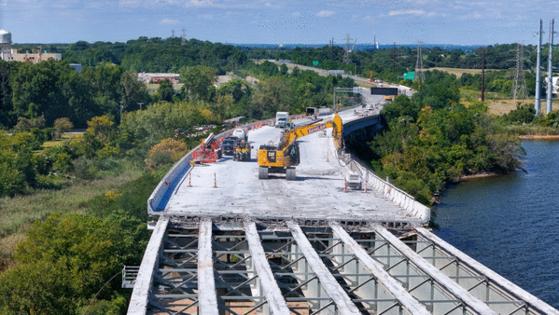Sound of bells mean progress for Key Bridge rebuild
Published in News & Features
BALTIMORE — The sound of bells drifting across the Inner Harbor is a welcome sound to state transportation officials and lawmakers who have championed a new Francis Scott Key Bridge.
Since Saturday, crews have been driving 12 test piles — massive steel posts hammered deep into the riverbed to support the new bridge — into the Patapsco River.
Each pile takes about two hours to install, producing a resonant sound that carries across the harbor and, from a distance, resembles a tolling bell. The work will continue for six to eight weeks, Monday through Saturday, during daylight hours, according to the Maryland Transportation Authority.
Officials said the testing is critical to confirm soil conditions before permanent piles can be set. The “bells,” which can be heard as far as Harbor East, serve as a fitting metaphor for progress on the bridge’s reconstruction.
“The Key Bridge was a vital transportation artery and gateway to the Port of Baltimore, and the federal government’s commitment to fund the rebuild was enacted in law,” U.S Rep. Steny Hoyer, a Maryland Democrat, posted on social media. “Team Maryland will keep working with the U.S. Department of Transportation to deliver on this national priority and commitment.”
His comments were echoed by fellow Maryland Democrat and U.S. Rep Johnny Olszewski.
“Emergency infrastructure projects, such as the Key Bridge and the 2023 Pennsylvania highway collapse, demand innovative solutions to ensure fast and safe reconstruction,” Olszewski said. “I’m encouraged by the recent progress and remain committed to supporting any and all efforts aimed at expediting the rebuild, which is critical to both our regional and national economies.”
Detailing the process
The process began with a crane and tripping barge lifting each pile into position. Crews then stabilized it with a vibratory hammer before driving it into the riverbed with a hydraulic hammer. Later, load frames will apply vertical and horizontal pressure while sensors capture real-time data to validate design models.
Noise and vibration monitors have been installed in the project area and surrounding neighborhoods. These devices, which have been gathering baseline data, will continue tracking construction activity to ensure it stays within acceptable limits, officials said.
“The Test Pile Program marks another major milestone in the Key Bridge rebuild,” said MDTA Executive Director Bruce Gartner. “Some of the test piles will be evaluated for possible use in the permanent foundations of the new bridge.”
Federal funding secured
The Key Bridge rebuild is estimated to cost between $1.7 billion and $1.9 billion. Congress approved full federal funding in December, though President Donald Trump has since threatened to withhold money over what it called “unconstitutional DEI practices.” The project is expected to be completed in October 2028.
“This is an important milestone in the plan to build a stronger, safer bridge over the Patapsco — and is made possible by the commitment we secured to ensure that the federal government will provide the funding necessary for the project,” said Sen. Chris Van Hollen. “We will keep working to complete the restoration of this vital artery for transportation and commerce across the Greater Baltimore region.”
The reconstruction follows the catastrophic collapse of March 26, 2024, when the container ship Dali lost power and struck one of the bridge’s support piers. The 112,000-ton vessel caused the structure to fail instantly, sending vehicles and highway workers into the river. Six construction workers died, and maritime traffic to the Port of Baltimore was halted for weeks.
--------------
©2025 The Baltimore Sun. Visit at baltimoresun.com. Distributed by Tribune Content Agency, LLC.







Comments